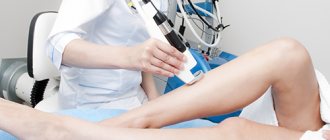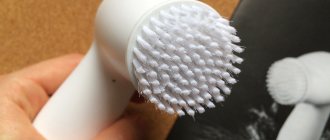What is a laser facial hair removal procedure?
Laser facial hair removal is an innovative depilation technique, the essence of which is the effect of thermal flashes on the hair follicles. Penetrating through the epidermis, the laser beam passes through the entire hair, and when it reaches the bulb, it heats it, as a result of which the follicle is destroyed and falls out. The laser only affects hairs that are in the active growth stage, so several sessions (from 4 to 10) are necessary to completely remove all hair.
After the procedure, hair growth stops for several years, and the newly appeared hair becomes lighter and softer. This procedure is suitable for both women and men.
Which type of laser is better?
There are several types of laser systems to remove unwanted vegetation. They are distinguished by a long laser wave that removes hair roots. There are also differences in the degree of exposure or trauma to the epidermis:
- The Alexandrite laser performs the fastest procedure. Its laser wavelength is 755 nm. Hair melatonin absorbs the entire light beam, so there are minimal side effects and injuries to the epidermis. This type of device is suitable for dermis of different types and shades, including delicate areas with freckles and age spots. The penetration rate is high, high effect on light hairs. For dark tanned and dark skin, it is better to choose a different type of laser.
- Ruby laser is the first type of hair removal device. The dermal layers around the hair follicles are virtually undamaged. This is a rather outdated procedure that has a number of disadvantages - it is applicable only on small areas of the dermis, and is not suitable for bleached, thin and gray hairs. The procedure itself takes a long time, but the effect lasts for several years, and re-growth of hair also slows down.
- A neodymium laser operates in several modes at once, with different wavelengths. Effective for all dermis types, flash recurrence rate is high. This device is suitable for large areas of the body - back, legs, arms. Hair grows much slower, does not grow into the skin and does not form hard stubble. At the moment, this is the most advanced device for hair removal.
- A diode laser device operates using semiconductors and diodes. The wavelength can be adjusted for a specific person and their hair type. The device is great for thick and dark hair and dark skin. The procedure is popular among the strong half of humanity who want to cleanse the chest and back. If the laser is used incorrectly, noticeable burns may occur; it is not suitable for light dermis and fine hairs. The time spent on hair removal is quite long. Allergies may occur.
There are IPL light machines that create short bursts of special light. The procedure can be performed at home. Light beams spread into the deep layers of the epidermis and dissolve hair follicles.
These are not full-fledged laser devices, but they are suitable for eliminating both dark and light hairs.
Facial hair removal areas
There are the following areas for laser facial hair removal.
Hairline
Sometimes the hairline is too low. Laser hair removal allows you to lift it a little, changing the appearance. A course of depilation of the hairline consists of 4-5 sessions, between which there is a break of 2-3 weeks.
Forehead
A drooping forehead is a common problem that can be corrected with laser hair removal. After the first session, the forehead rises, becomes higher and more open.
The space around and between the eyebrows
The ideal eyebrow shape is every girl's dream. Using laser hair removal, you can eliminate unibrows and give your eyebrows a clear, beautiful shape that will last for many years. The form is selected individually by a cosmetologist.
Cheeks
Constant shaving of cheek hair in men causes severe discomfort and irritation. Laser hair removal removes hair painlessly and safely for a long time.
The so-called sideburns
Removing sideburns allows you to make the contours of the face and hairstyles clearer in men, and makes women more attractive and tender.
Ears
Excision of ear hairs is the simplest and safest procedure, since the amount of hair is small and the skin is less sensitive and almost not prone to irritation.
Nose (surface and mucous membrane)
Nasal depilation is one of the most difficult and unpleasant procedures, since the mucous membrane is too sensitive and the hairs are inaccessible. Laser hair removal allows you to remove nasal hair quickly and almost painlessly.
Upper lip (the notorious mustache)
Mustaches are a common problem among women. They give an unaesthetic appearance and significantly reduce self-esteem. Radical hair removal above the upper lip is performed in 4-5 sessions. The laser is applied from the corner of the mouth to the middle of the lip.
Chin
Laser hair removal of the chin in women allows you to get rid of protruding villi and an unsightly beard. A laser epilator cuts out vegetation quickly, for a long time and without negative consequences.
Neck
Many men and women suffer from low hairline at the back of their heads. Laser hair removal helps to gently eliminate this problem by removing hair from the entire circumference of the neck through non-contact pulsed laser action.
Indications for laser hair removal
This technique is suitable for anyone who wants to permanently get rid of body or facial hair.
Direct indications include:
- excessive male pattern hair growth in women;
- frequent occurrence of irritation and cuts after shaving;
- ingrown hairs after other removal methods;
- complexes about appearance.
Hirsutism in women appears as dark, thick hairs on the chin, décolleté, and above the upper lip. Hair is actively growing on the legs and arms, in the navel area. It is better to have the problem resolved by an endocrinologist, and an aesthetic problem can be solved in a beauty salon.
Preparing for the hair removal procedure
Laser hair removal is more of a medical than a cosmetic procedure, so a preparatory stage must follow before it is carried out. How to prepare for laser hair removal on your face? To do this, you must first consult with a specialist and make sure there are no contraindications, and then follow the following recommendations:
- 2 months in advance you need to stop removing hair by any method other than shaving or chemical depilation;
- at the time of hair removal, the length of the hairs should be 3-5 mm, so in 2-3 days you need to remove the hair superficially;
- 2-3 weeks in advance you need to stop sunbathing and visiting the solarium;
- within a couple of weeks you should stop using alcohol-based cosmetics;
- 14 days in advance you must stop taking tetracycline antibiotics and some other drugs;
- Peeling cannot be done later than 3 days before the session.
It is not recommended to do laser hair removal during menstrual periods or in the first week after them, as pain intensifies during this time. You can learn about other necessary preparatory measures during a consultation with a specialist.
What happens after laser hair removal
Immediately after hair removal, slight redness is visible. It goes away in a couple of hours. Sometimes cosmetologists recommend using anti-inflammatory creams or ointments. Single hairs may stick out in the treatment areas, but they will become dead and fall off over time.
After the session, it is not advisable to wet the dermis or apply any cosmetics to it. Over the next few weeks, you should not visit a sauna or bathhouse, so as not to harm the skin and cause inflammation of the hair follicles.
Do not stay in direct sunlight for a long time or sunbathe in a solarium.
Hair falls out on average within 2-3 weeks after the procedure. It all depends on their thickness, structure, depth of the root system. Subsequently, you will have to repeat the session to eliminate the remaining 20-30% of hair growth.
How does laser hair removal work on the face?
After all the preparatory activities have been completed, you can proceed directly to depilation. Laser facial hair removal for women is carried out as follows:
- The specialist determines the client’s phototype and, based on the data obtained, sets the appropriate parameters on the equipment.
- If the patient is afraid of pain, then an anesthetic is applied 30-60 minutes before the procedure. The type of pain relief is selected individually in advance. The most commonly used is lidocaine spray or ointment.
- The client is placed comfortably on a couch, face up, and wears special safety glasses to prevent eye damage.
- The master thoroughly cleanses the patient’s skin of cosmetics and dirt using special cosmetics.
- Using a pencil, contour points are placed on the skin to define the depilation area.
- The specialist moves the laser over the designated area, directing the beam at the hairs that need to be removed. This operation is carried out without contact, therefore eliminating the possibility of damage and infection of the skin.
- At the end of the procedure, the remaining anesthetic is removed, and a special soothing and cooling agent is applied.
Laser hair removal on the face usually takes only 10-15 minutes and is accompanied by minimal pain, so there is often no need for pain relief.
Possible consequences and side effects of laser hair removal
The incompetence of a cosmetologist and ignoring contraindications can lead to unpleasant consequences.
| Type of early complications | Cause of occurrence |
| Unprofessionalism of a specialist, incorrect choice of device or gel. Skin sensitivity in the deep bikini area. |
| Hair “nests” become inflamed with a tendency to hyperhidrosis, as well as due to visiting the pool between sessions. |
| Occurs when treating the area around the mouth or the deep bikini area if the patient has a history of herpes. |
| It is a reaction to topical painkillers, gas and cosmetics. Manifests itself in the form of urticaria, itching, dermatitis. |
| The patient did not wear special glasses or contact lenses when treating the eyebrow area. |
Late side effects include scarring, increased hair growth, and hyperpigmentation. When epilating the armpits with a diode and alexandrite device, bromhidrosis and leukotrichia may develop.
Complications: how to avoid or minimize them?
There will be no health consequences from laser hair removal if you choose a cosmetologist responsibly.
A competent specialist will select the device, type of radiation, and exposure parameters, taking into account the individual characteristics of the client.
The patient himself must study the contraindications and consult with his doctor. He will advise you to complete the treatment or prescribe a drug. For example, if you have a herpes virus, take antiviral medications 2 days before hair removal. Before the sessions, the cosmetologist will tell you the rules for preparing for the procedure. All recommendations must be strictly followed.
Myths about laser hair removal
The most common myth about laser follicle removal is the risk of disease. There is an opinion that the consequence of laser hair removal of the bikini is infertility, and treatment of the armpits is breast cancer. This is impossible, since the rays act pointwise, only on the hair or its “root”. The waves are short and penetrate only the superficial layer of the dermis.
The INFINITI network of laser hair removal salons offers the services of qualified cosmetologists. Epilation of any zones is performed at an affordable price.
Features of male facial hair removal
Laser hair removal is very popular among men. With its help it is possible to eliminate the following problems:
- skin damage and irritation after frequent shaving;
- prickly, hard stubble;
- ingrown hairs;
- unsightly hairline;
- hyperhidrosis.
The process of laser hair removal of the chin and cheeks for men is carried out in the same order as for women, however, due to the increased rigidity of the hair, about 10-12 sessions will be required to achieve the desired result. The duration of the result is only 2-3 years, after which the course must be taken again.
Required number of procedures[edit | edit code]
Hair grows in several stages (anagen, telogen, catagen) and the laser can only affect the actively growing hair (early anagen). Therefore, in order to remove as much hair as possible, it is necessary to do several procedures every month. This way you can treat your hair at all stages.
Several procedures, depending on hair type and skin color, provide long-term hair reduction. Most patients require at least 7 treatments. Current settings vary from device to device, but manufacturers and clinicians generally recommend waiting three to eight weeks between sessions, depending on the area being treated. The number of sessions depends on various parameters, including body area, skin color, hair coarseness, cause of hirsutism and gender. Coarse dark hair on fair skin is the easiest to remove. Some areas (particularly men's faces) may require significantly more treatments to achieve the desired result.
The laser does not work very well on light colored, red, gray hair, as well as fine, vellus hair of any color. For darker skin with black hair, a long-pulse Nd:YAG laser with a cooling tip is used, making the procedure safe and effective when used by an experienced practitioner.
For the facial area, 4-8 sessions are usually required. Hair in the armpit and bikini area is removed in 3-5 procedures. In case of hormonal disorders, the effectiveness of laser hair removal may be reduced, therefore, before using this technique, it is necessary to normalize the level of hormones and undergo a course of treatment from an endocrinologist.
Possible complications
Laser hair removal is a relatively safe procedure. However, if contraindications and specialist recommendations are neglected, the following unpleasant consequences may be observed after depilation:
- burns;
- subcutaneous bruising;
- hyperpigmentation;
- scarring;
- folliculitis.
Laser hair removal can provoke an exacerbation of chronic diseases and cause endocrine disorders and increased hair growth. If safety precautions are neglected, visual damage may occur. You can avoid such complications if you follow all the specialist’s recommendations and choose a good, experienced specialist.
Devices for laser hair removal in Russian salons
Laser installations, based on wavelength, are divided into:
- Diode
- Ruby
- Niodymium
- Alexandrite
None of the installations is a magic wand that can rid you of all hair at once, but the diode laser is recognized as the most effective today, due to the wavelength to which the melanin of the hair is most susceptible.
Contraindications
It is prohibited to perform facial hair removal with laser if you have the following diseases:
- diabetes;
- phlebeurysm;
- infectious pathologies;
- herpes;
- oncological processes;
- inflammatory processes;
- dermatological diseases;
- ARVI, cold.
You should refrain from laser hair removal if there are any lesions on the skin, pigment spots, moles or benign neoplasms. It is strictly forbidden to carry out the procedure during pregnancy, as pain can provoke an increase in the tone of the uterus and seriously harm the baby. During lactation, such manipulations should also be avoided. This method of depilation can only be performed from 18 years of age.
Contraindications for depilation
Despite the apparent simplicity of the depilation procedure, there are a number of contraindications to manipulations to remove unwanted hair. Contraindications are divided into absolute (preclude the procedure) and relative (the procedure is undesirable, but possible).
Absolute contraindications for hair removal:
-DIABETES MELLITUS is a very serious disease that leads to serious infectious complications, sometimes life-threatening. Stories from life when the Brazilian depilation procedure almost led to the death of a 20-year-old Australian woman. The woman was taken to intensive care two weeks after the procedure, according to the journal Clinical Infectious Diseases. “This case is very serious because it illustrates the risk of infection during bikini hair removal in patients with diabetes,” the author writes. “The beauty industry is growing by leaps and bounds, and quite invasive and dangerous procedures are becoming more accessible.” The author of the note warns anyone with problems with the immune system, including diabetics and HIV-infected people: “Think twice before do bikini hair removal, or any other beauty procedure.”
-TOPICAL RETINOIDS (vitamin A derivatives) are a contraindication for facial hair removal!!!! Typically used to treat acne, as well as whitening age spots. One of the mechanisms of action of retinoids is exfoliation of epidermal cells, which is quite deep. As we remember, during depilation, cell exfoliation also occurs. If we combine retinoids and depilation, then we get persistent redness of the skin, crusts, pigment spots!!!! What to do? After all, it is impossible to decide what is more important: the absence of oily shine and acne, or smooth skin above the upper lip!!!
1. Try sugar hair removal instead of waxing. As you know, sugar paste is less damaging to the skin. 2. Use thread depilation. How much time should pass between using retinoids and waxing? About 6 months! In this case, it is necessary to conduct a test on a small area of skin 24 hours before the planned procedure))) Be competent specialists! Interview clients before the procedure!
-PAPILLOMAS and depilation. Currently, quite often in the bikini area we encounter papillomas. And here the question arises: is it possible to do hair removal? If papilloma is discovered for the first time, you need to contact a gynecologist who will prescribe an examination, because Different types of human papillomavirus (HPV) can pose different health risks. If the virus is non-oncogenic, then depilation can be done, but carefully avoiding rashes. The most convenient way to do this is with sugar paste. Electrolysis is also suitable. But it is best to remove papillomas and not suffer.
-TAKEN ORAL CONTRACEPTIVES and some ANTIBIOTICS can lead to changes in the sensitivity and reactivity of the skin. Therefore, it is very important to conduct a skin test on a small area of the arm or leg one day before depilation. After 24 hours, you need to evaluate the skin reaction. If everything is fine, that means the green light. We can do the procedure without worrying about anything. If the skin reacts inappropriately (redness, irritation, itching, swelling, etc.), then you need to wait.
— One of the most exciting periods of a woman’s life is PREGNANCY, which brings a lot of pleasant troubles. But at this time, everyone may encounter a number of minor troubles. One of them is body hair removal. Not only does self-removal become inconvenient and require outside help as pregnancy progresses, but hair may also appear where there was none before: the face, abdomen, area around the nipples; or start growing more actively on your arms and legs. This is a temporary phenomenon that will go away after childbirth. Whether or not to do the depilation procedure depends on many parameters, but in case of any problems, it is better to refuse depilation. Read more in detail here.
-Hypertension and coronary heart disease. Painful sensations can cause a hypertensive crisis. In this regard, the master always needs to have tablets that reduce blood pressure with him.
-Exacerbation of herpetic infection. Carrying out hair removal at the site where herpes appears can cause it to spread to larger areas.
-Allergic reactions. There are allergies to cosmetics and wax, as well as skin reactions to mechanical stress. Any case of allergies should alert the cosmetologist; in this situation, the client should be advised to immediately consult an allergist.
-Intolerance to painful sensations. Unfortunately, when performing depilation, the use of skin anesthetics does not give the expected result, therefore, with a low pain threshold, the depilation procedure becomes difficult to implement.
-PLACES where waxing is NOT RECOMMENDED
• inflamed, damaged skin • sunburned skin • areas where retinoic peels are used • varicose veins • areas where there are fresh scars, cold sores, pimples, moles or warts • areas where dermoabrasion was performed (within 3 month) • any area within 3-7 days after Botox • the inside of the nose, ears, around the nipples and on the male genitals • on any areas if 24 hours have not passed since the previous depilation • in the piercing area
Sometimes in these places you can use alternative methods of hair removal - plucking with tweezers or sugaring! In any case, consult a professional!
Relative contraindications:
-Infectious and colds. It all depends on the degree of discomfort. For mild forms of a cold, depilation should not lead to any deterioration in well-being.
-Fresh tan. All the beauty of a newly acquired tan can be used for depilation, especially when it comes to waxing. To prevent this from happening, it is necessary to use high-quality cosmetics, and it is also advisable to do the procedure using sugar paste, it exfoliates the skin more gently.
- Menstruation period. Depilation performed at different times of the menstrual cycle can give completely different effects. The first half of the cycle The procedure is tolerated quite easily. The skin recovers quickly and is less damaged. Experts are sure that the most ideal time for depilation is 2-3 days after the end of the critical days. Mid-cycle (ovulation) Increased sensitivity may occur. But this time is considered the most favorable for slowing down hair growth. If you depilate during this period, the growth rate of “unwanted vegetation” will slow down by 30-40%. Second half of the cycle Pain increases, especially a week before menstruation. Therefore, it is better to refuse depilation.
Always remember about contraindications, thereby you can protect yourself and your clients from unwanted consequences!
Facial care after the procedure
To avoid negative consequences after laser hair removal of the face, it is necessary to provide the skin with proper care. To do this, follow the following recommendations:
- for the first day, do not allow water to come into contact with the depilated area of the skin;
- for 3 days, refuse a hot bath and any thermal procedures;
- For several days after depilation, refrain from using alcohol cosmetics;
- Sunbathing is prohibited for 14 days; sunscreen must be applied to the skin before going out in the sun;
- Do not have an aggressive effect on the skin (peeling, massage).
In the intervals between sessions, you cannot use other methods of depilation. If the hairs have grown a lot, then they can be trimmed a little. If severe irritation or complications occur, you should consult a doctor to select medications.
Comparisons with other removal techniques[edit | edit code]
Electrolysis
Comparison with Intense Pulsed Light (IPL)
In 2006, the journal Lasers in Medical Science published a review article comparing hair removal methods using IPL, alexandrite and diode lasers. The review found no statistical difference in short-term effectiveness (6 months) but a higher incidence of side effects with diode laser. Hair reduction after 6 months was 68.75% for alexandrite laser, 71.71% for diode laser, and 66.96% for IPL. Side effects were reported as 9.5% for the alexandrite laser, 28.9% for the diode laser, and 15.3% for the IPL. All side effects were temporary and even pigmentation returned to normal within 6 months.[10]
The IPL laser, although technically not containing a laser, is sometimes incorrectly referred to as "laser hair removal." ELOS methods, sometimes called "phototricholysis" or "photoepilation", use xenon flash lamps that emit a full spectrum of light. IPL systems typically have wavelengths in the range between 400 nm and 1200 nm. Filters are used to block shorter wavelengths, thereby only using longer, “redder” wavelengths for clinical use. The main advantage of IPL laser hair removal is that it uses a longer light pulse of up to 250 ms, which is beneficial for larger target diameters.[11][12][13]
Comparison with electrolysis
Electrolysis is another hair removal method that has been used for over 135 years.[14] Unlike laser hair removal, electrolysis can be used to remove 100% of visible hair from the treated area and works on hair of all colors if used at the proper power level with the correct technique.
A 2000 study conducted at the ASVAK Laser Center in Ankara, Turkey, comparing alexandrite laser and electrolysis for hair removal on 12 patients concluded that laser hair removal was 60 times faster, less painful and more reliable than electrolysis. Also, the latter requires contact of the current with the hair for 30 seconds to or more than a minute (which is very painful) to release each hair, while light hair removal requires much less time.[15]
How painful is it to do laser hair removal - the pain of the procedure
Laser hair removal is painless, but sensitive . Moreover, the sensitivity depends on the power of the laser beam. As the power decreases (different for each zone), the number of procedures increases.
Important features of laser hair removal
In case of hormonal imbalances, it is impossible to determine the exact number of procedures. As a rule, if there is an imbalance of hormones, additional sessions of the procedure are required. The reason is the continuation of the formation of hair follicles, which delays the final result.- No laser installation guarantees smooth skin , reminiscent of paper gloss.
- Laser hair removal will not bring results if you want to get rid of gray hair . Therefore, gray hair and “blondness” should be removed in another way (for example, electrolysis).
- The risk of a burn directly depends on the degree of dark skin . A person with dark skin, in this case, should first conduct a sensitivity test.
- High-quality hair removal requires complete hair growth .
- Redness after hair removal is a natural skin reaction. It goes away within 20 minutes after a specialist applies a special product.
- an anesthetic cream an hour before the procedure .
Laser hair removal - to prevent hair from growing after the procedure
After hair removal you should not sunbathe for a month . Also exclude the solarium at this time.- For the first three days, you need to use antibiotic cream and Panthenol (Bepanten) for the hair removal area in the morning and before bed (each drug for 10 minutes, sequentially).
- The use of cosmetics containing alcohol, scrubs and other skin irritants should be stopped or limited for a while.
- When showering and washing your face the first three days after hair removal, it is recommended to use cool water . A bathhouse with a sauna and a swimming pool should be excluded.
- For two weeks, do not forget to use a protective cream with an SPF of 30 .
- The use of depilatory creams, wax, vibrating epilator or tweezers is prohibited between procedures.
- As for fine hair, they are eliminated with the first flash . Coarse hair leaves tiny roots. Absolute death of the hair follicle (as well as the subsequent independent loss of the intradermal part of the hair) occurs within a week or two after the procedure , so it is not recommended to pull out such roots.
One of the main recommendations: carefully choose a salon . Go to the company’s website, study reviews about it online, ask about the features of hair removal, equipment and qualifications of specialists.










